
Wild cousins...

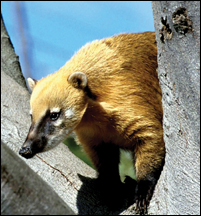 There
are many creatures in the Animal Kingdom we are not at all familiar
with, and so we intend to introduce you to as many such animals as
possible through Nature trail. We hope you enjoyed reading about the
cute little marsupial, the bilby we featured recently which is not only
unique, but is also becoming an icon in Australia. There
are many creatures in the Animal Kingdom we are not at all familiar
with, and so we intend to introduce you to as many such animals as
possible through Nature trail. We hope you enjoyed reading about the
cute little marsupial, the bilby we featured recently which is not only
unique, but is also becoming an icon in Australia.
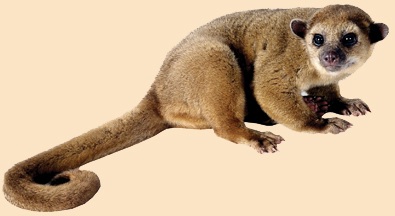 Today
too, we feature two more animals with strange sounding names - real
tongue-twisters. These two mammals are related, but very different in
appearance and behaviour. Let's see how these two relations survive in
the wild... Today
too, we feature two more animals with strange sounding names - real
tongue-twisters. These two mammals are related, but very different in
appearance and behaviour. Let's see how these two relations survive in
the wild...
The kinkajou (Potos flavus) is a rainforest mammal which belongs to
the Procyonidae family and is related to the red panda, olingo, ring
tail, cacomistle, raccoon and the coati. It is a native of Central
America and South America.
The kinkajou is not rare, however it is seldom seen due to its strict
nocturnal (night-time) habits. In Belize it's known as the 'night
walker'.
It is often mistaken for a ferret or a monkey due to its appearance.
Its head is round with roundish ears, giving it a cat-like appearance.
The eyes are very prominent and when a light is flashed at them, they
reflect light for a long distance at night. It has a long body which is
covered by a short, soft furred coat that is either honey gold or brown
in colour.
The legs are rather short with the toes joined by a membrane which
extends a third of the way, down each toe. The palms are bare, like that
of the monkey. It also has a fully prehensile (gripping) tail to aid in
climbing, similar to that of the monkey, but it does not use it to hold
food.
It can also rotate its feet backwards so that it can hang from
branches of trees. It has scent glands which are located on the face,
throat and belly area. It reaches a head to body length of about 16-22
inches as an adult and has a tail that is equally long. Its weight is
between 4 and 10 lbs.
 |
The kinkajouís tongue can
be
extended up to five inches. |
 The
kinkajou is a solitary and nocturnal creature which sleeps in the hollow
of trees or leaves during the day to avoid sunlight. It often covers its
eyes with its front feet. As an arboreal animal, it spends most of its
time in the forest canopy and rarely comes down. What do you think it
eats up there in the tree canopy for survival? Small bees and insects,
tree-living frogs, nesting birds, eggs and also honey in addition to
fruits, nectar and blossoms. In fact, it has a tongue which is
stretchable to about five inches; it helps the kinkajou to obtain nectar
from flowers. The
kinkajou is a solitary and nocturnal creature which sleeps in the hollow
of trees or leaves during the day to avoid sunlight. It often covers its
eyes with its front feet. As an arboreal animal, it spends most of its
time in the forest canopy and rarely comes down. What do you think it
eats up there in the tree canopy for survival? Small bees and insects,
tree-living frogs, nesting birds, eggs and also honey in addition to
fruits, nectar and blossoms. In fact, it has a tongue which is
stretchable to about five inches; it helps the kinkajou to obtain nectar
from flowers.
When the kinkajou extends its tongue to get at the pollen its face
too eventually gets covered with pollen, which gets carried to other
places by it. So, it is considered a pollinator of the rainforest.
When eating fruits the kinkajou could be seen hanging upside down
from the branches in order to avoid missing out on any juices that ooze
out from the fruits it's eating.
There are various sounds the kinkajou makes to communicate with other
members of its family, which includes soft huffing, chirping and a
barking noise similar to yelping. It also uses a small 'peep' sound for
close communication and a shrill scream for far-reaching calls.
The female gives birth to one or sometimes two cubs after a gestation
(pregnancy period) of 112-118 days. The cubs are born with their eyes
and ears closed. The eyes open within 2-6 weeks and after another 3-6
weeks their little tails become prehensile (develop gripping ability).
The mother is very protective of her babies and in times of danger,
carries the cub (or cubs) upside down, just below her chest.
In general, she carries them about for nearly four months by which
time they are almost independent.
Researchers have identified about 14 different subspecies going by
location and variations in size, fur length and colour.
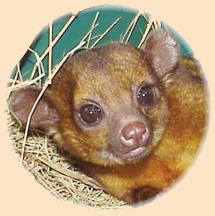  Kinkajous
are kept as pets and if hand-reared from a very small age, they could be
quite tame. Due to loss of habitat and the pet trade, the kinkajou
population is said to be on the decline. Its natural predators are
foxes, tayras, jaguars and ocelots. Its lifespan in captivity is said to
be around 23 years, but some have lived longer. A kinkajou named Sugar
bear which was the oldest kinkajou in captivity at the Honolulu Zoo
celebrated its 40th birthday in June 2002, but died the following year. Kinkajous
are kept as pets and if hand-reared from a very small age, they could be
quite tame. Due to loss of habitat and the pet trade, the kinkajou
population is said to be on the decline. Its natural predators are
foxes, tayras, jaguars and ocelots. Its lifespan in captivity is said to
be around 23 years, but some have lived longer. A kinkajou named Sugar
bear which was the oldest kinkajou in captivity at the Honolulu Zoo
celebrated its 40th birthday in June 2002, but died the following year.
The Coati which also belongs to the procyonidae family and is related
to the kinkajou, is also known as the hog-nosed coon, snookum bear and
Brazilian aardvark. This mammal is a native of South America, Central
America and the south-western parts of North America.
With a head to base length of 33-69 cm (13-27 in) and a tail which is
as long as the body, the coati is larger than the kinkajou. It stands at
30cm (12 in) at shoulder length and weighs 3-8 kg (6-18 lbs), the size
of a large domestic cat. Males may be twice as large and have sharp
canine teeth.
Like most members of its family, the coati too has a cat-like
appearance. It has small ears, a slender head, elongated and flexible
nose which is upturned, a long, non-prehensile tail (which is used
mostly for balance) and dark feet. The snout which is somewhat like a
pig's, is extremely flexible and can be rotated 60 degrees in any
direction.
The tip of the tale can also be moved, a bit like in cats, but not
the way the kinkajou can. It has bear and raccoon-like paws and
generally walks on the soles of the feet as do people. The claws are
non-retractable. Its double-jointed ankles can be rotated 180 degrees.
This gives the coati the ability to come down trees, head first. Its
limbs too are very strong.
The fur coats are either light brown or black and it has defined
(clear cut) facial markings; white markings are found around the eyes,
ears and snout.
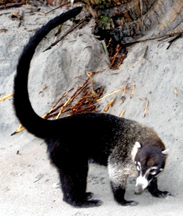 |
|
A male coati |
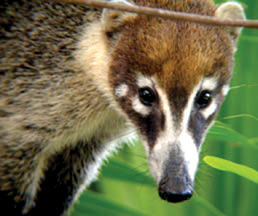 |
|
The long
snout is extremely flexible |
The coati's habitat is widespread, ranging from hot and arid areas to
humid Amazonian rainforests and cold Andean mountain slopes including
grasslands and bushy areas in southern Arizona, USA and in
Argentina.It's intelligent like the raccoon and prefers to sleep and
rest in elevated places and niches, the rainforest canopy and crudely
built nests.An omnivorous creature, the coati's diet includes ground
litter, invertebrates, fruits, small vertebrates like lizards, rodents
and birds and also birds' eggs. Its formidable sense of smell along with
skilled paws help it to unearth invertebrates.
Unlike most members of the raccoon family, the coati is primarily a
diurnal animal. Females and young males up to two years are gregarious
(like to live in groups) and travel through their territories in loosely
organised bands comprising 20-25 individuals. However, the males over
two years end up living solitary lives until reproduction time, mostly
due to the collective aggression of the females in the group.
The coati is a fierce fighter, especially when it's provoked. Its
strong jaws, sharp teeth, fast scratching paws and thick hide make it
difficult for its predators, such as dogs and jaguars to seize this
small mammal.
Now, let's see how it communicates. Apart from the various sounds
such as chirping, snorting or grunting it makes to make known its
intention or mood, the coati also uses special moves and postures, to
convery simple messages. For example, it hides its nose behind its paws
as a sign of submission and lowers its head, bearing its teeth, then
jumps at once, as a sign of aggression.
The coatis recognise each other by individual smell, voices and looks
too. Special musk glands on neck and bellies are responsible for the
individual smell the animals have.Breeding season coincides with the
start of the rainy season because maximum advantage could be taken of
the food available during this time, especially the fruits. After a
gestation (pregnancy) period of 11 weeks, the coati mum gives birth to a
litter of 3-7 young.
During the pregnancy, the mama-to-be normally leaves the group and
stays on its own. It rejoins the group only when its babies are about
six weeks old. Female coatis reach maturity by two years while males do
so when they are three years old.
Who do you think a coati's natural enemies are? The jaguarundis,
foxes, tayras, ocelots, jaguars, hawks, eagles... and yes, we humans
too!
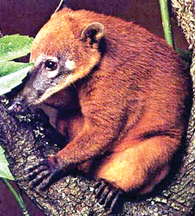 Researches
have recognised three to four species of coati and they are the
ring-tailed, the white-nosed and the island coati. However, the
differences between these different species are not very marked; for
instance, the white-nosed coati has the normal black nose all coatis
have except for the fact that its muzzle (area around the nose) or snout
is white in colour. Researches
have recognised three to four species of coati and they are the
ring-tailed, the white-nosed and the island coati. However, the
differences between these different species are not very marked; for
instance, the white-nosed coati has the normal black nose all coatis
have except for the fact that its muzzle (area around the nose) or snout
is white in colour.
The ring-tailed coati has the light brown and black coats with
lighter under parts and white-tinged tails. The long, brown tails with
rings like a raccoon's are normally held erect.
Generally these tails come in handy to keep the group together
especially in tall vegetation. Here's an important fact about the coati
you should keep in mind if you happen to visit coati land. Never leave
any substances with the smell of soap or perfume around a coati. It's
famous for dipping its nose into it! |

